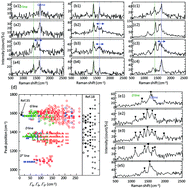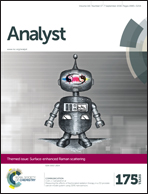Recent topics on single-molecule fluctuation analysis using blinking in surface-enhanced resonance Raman scattering: clarification by the electromagnetic mechanism
Abstract
Surface-enhanced Raman scattering (SERS) spectroscopy has become an ultrasensitive tool for clarifying molecular functions on plasmonic metal nanoparticles (NPs). SERS has been used for in situ probing of detailed behaviors of few or single molecules (SMs) at plasmonic NP junctions. SM SERS signals are commonly observed with temporal and spectral changes known as “blinking”, which are related to various physical and chemical interactions between molecules and NP junctions. These temporal and spectral changes simultaneously take place, therefore resulting in serious complexities in interpretations of the SM SERS results. Dual contributions of Raman enhancement mechanisms in SERS (i.e., electromagnetic (EM) and chemical enhancements) also make interpretations more difficult. To resolve these issues and reduce the degree of complexities in SM SERS analyses, the present review is focused on the recent studies of probing SM behaviors using SERS exclusively within the framework of the EM mechanism. The EM mechanism is briefly introduced, and several recent topics on SM SERS blinking analysis are discussed in light of the EM mechanism. This review will provide a basis for clarification of complex SERS fluctuations of various molecules.

- This article is part of the themed collection: Surface-enhanced Raman scattering

 Please wait while we load your content...
Please wait while we load your content...